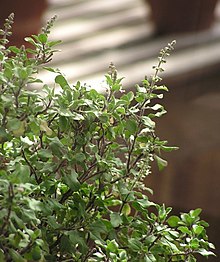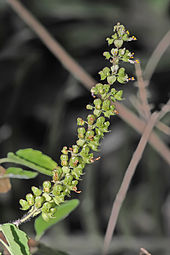Ocimum tenuiflorum
| Ocimum tenuiflorum | |
|---|---|

| |
| Scientific classification | |
| Kingdom: | Plantae |
| Clade: | Tracheophytes |
| Clade: | Angiosperms |
| Clade: | Eudicots |
| Clade: | Asterids |
| Order: | Lamiales |
| Family: | Lamiaceae |
| Genus: | Ocimum |
| Species: | O. tenuiflorum
|
| Binomial name | |
| Ocimum tenuiflorum | |
| Synonyms[1] | |
| |
Ocimum tenuiflorum (synonym Ocimum sanctum), commonly known as holy basil, tulasi (sometimes spelled thulasi) or tulsi, is an aromatic perennial plant in the family Lamiaceae. It is native to the Indian subcontinent and widespread as a cultivated plant throughout the Southeast Asian tropics.[2][3]
Tulasi is cultivated for religious and traditional medicine purposes, and for its essential oil. It is widely used as a herbal tea, commonly used in Ayurveda, and has a place within the Vaishnava tradition of Hinduism, in which devotees perform worship involving holy basil plants or leaves.
The variety of Ocimum tenuiflorum used in Thai cuisine is referred to as Thai holy basil (Thai: กะเพรา kaphrao);[2] it is not to be confused with Thai basil, which is a variety of Ocimum basilicum.
Morphology



Holy basil is an erect, many-branched subshrub, 30–60 cm (12–24 in) tall with hairy stems. Leaves are green or purple; they are simple, petioled, with an ovate, up to 5 cm (2.0 in)-long blade which usually has a slightly toothed margin; they are strongly scented and have a decussate phyllotaxy. The purplish flowers are placed in close whorls on elongate racemes .[3] The two main morphotypes cultivated in India and Nepal are green-leaved (Sri or Lakshmi tulasi) and purple-leaved (Krishna tulasi).[4]
Origin and distribution
DNA barcodes of various biogeographical isolates of tulsi from the Indian subcontinent are now available. In a large-scale phylogeographical study of this species conducted using chloroplast genome sequences, a group of researchers from Central University of Punjab, Bathinda, have found that this plant originates from North Central India.[5][6] The discovery might suggest the evolution of tulsi is related with the cultural migratory patterns in the Indian subcontinent.
Uses
In Hinduism
Tulsi leaves are an essential part in the worship of Vishnu and his avatars, including Krishna and Rama, and other male Vaishnava deities such as Hanuman, Balarama, Garuda and many others. Tulsi is a sacred plant for Hindus and is worshipped as the avatar of Lakshmi.[7] It is believed that water mixed with the petals given to the dying raises their departing souls to heaven.[8] Tulsi, which is Sanskrit for "holy basil", is most often regarded as a consort of Krishna in the form of Lakshmi.[9][10] According to the Brahma Vaivarta Purana, tulsi is an expression of Sita.[11][full citation needed] There are two types of tulsi worshipped in Hinduism: "Rama tulsi" has light green leaves and is larger in size; "Krishna tulsi" has dark green leaves and is important for the worship of Hanuman.[12] Many Hindus have tulsi plants growing in front of or near their home, often in special pots. Traditionally, tulsi is planted in the centre of the central courtyard of Hindu houses. It is also frequently grown next to Hanuman temples, especially in Varanasi.[13][full citation needed]
According to Vaishnavas, it is believed in Puranas that during Samudra Manthana, when the gods win the ocean-churning against the asuras, Dhanvantari comes up from the ocean with Amrit in hand for the gods. Dhanvantari, the divine healer, sheds happy tears, and when the first drop falls in the Amrit, it forms tulasi. In the ceremony of Tulsi Vivaha, tulsi is ceremonially married to Krishna annually on the eleventh day of the waxing moon or twelfth of the month of Kartik in the lunar calendar. This day also marks the end of the four-month Chaturmas, which is considered inauspicious for weddings and other rituals, so the day inaugurates the annual marriage season in India. The ritual lighting of lamps each evening during Kartik includes the worship of the tulsi plant, which is held to be auspicious for the home. Vaishnavas especially follow the daily worship of tulsi during Kartik.[14] In another legend, Tulsi was a pious woman who sought a boon to marry Vishnu. Lakshmi, Vishnu's consort, cursed her to become a plant in earth. However, Vishnu appeased her by giving her a boon that she would grace him when he appears in the form of Shaligrama in temples.[15]
Vaishnavas traditionally use Hindu prayer beads made from tulsi stems or roots, which are an important symbol of initiation. Tulsi rosaries are considered to be auspicious for the wearer, and believed to put them under the protection of Hanuman. They have such a strong association with Vaishnavas, that followers of Hanuman are known as "those who bear the tulsi round the neck".[10]
Ayurveda
Tulasi (Sanskrit:-Surasa) has been used in Ayurveda for its supposed treatment of diseases.[16] Traditionally, tulasi is taken as herbal tea, dried powder, fresh leaf or mixed with ghee.

Thai cuisine
The leaves of holy basil, known as kaphrao in the Thai language (Thai: กะเพรา), are commonly used in Thai cuisine.[17] Kaphrao should not be confused with horapha (Thai: โหระพา), which is normally known as Thai basil,[17] or with Thai lemon basil (maenglak; Thai: แมงลัก). One dish made with this herb is phat kaphrao (Thai: ผัดกะเพรา) — a stir-fry of Thai holy basil with meats, seafood or, as in khao phat kraphao, with rice.
Insect repellent
For centuries, the dried leaves have been mixed with stored grains to repel insects.[18]
Chemical composition
Some of the phytochemical constituents of tulsi are oleanolic acid, ursolic acid, rosmarinic acid, eugenol, carvacrol, linalool, β-caryophyllene (about 8%).[19]
Tulsi essential oil consists mostly of eugenol (~70%) β-elemene (~11.0%), β-caryophyllene (~8%) and germacrene (~2%), with the balance being made up of various trace compounds, mostly terpenes.[20]
Genome sequence
The genome of Tulsi plant has been sequenced and reported as a draft, estimated to be 612 mega bases, with results showing genes for biosynthesis of anthocyanins in Krishna Tulsi, ursolic acid and eugenol in Rama Tulsi.[21]
Gallery
-
Tulsi grown in front of a house
-
An altar with tulsi plant for daily worship in a courtyard in India
References
- ^ "The Plant List: A Working List of All Plant Species". Retrieved 13 January 2015.
- ^ a b Staples, George; Michael S. Kristiansen (1999). Ethnic Culinary Herbs. University of Hawaii Press. p. 73. ISBN 978-0-8248-2094-7.
- ^ a b Warrier, P K (1995). Indian Medicinal Plants. Orient Longman. p. 168. ISBN 0-86311-551-9.
- ^ Kothari, S. K.; Bhattacharya, A. K.; Ramesh, S.; Garg, S. N.; Khanuja, S.P.S. (November–December 2005). "Volatile Constituents in Oil from Different Plant Parts of Methyl Eugenol-Rich Ocimum tenuiflorum L.f. (syn. O. sanctum L.) Grown in South India". Journal of Essential Oil Research. 17 (6): 656–658. doi:10.1080/10412905.2005.9699025.
{{cite journal}}: Unknown parameter|subscription=ignored (|url-access=suggested) (help) - ^ Bast, Felix; Pooja Rani; Devendra Meena (2014). "Chloroplast DNA Phylogeography of Holy Basil (Ocimum tenuiflorum) in Indian Subcontinent". The Scientific World Journal. 70 (3): 277–85. doi:10.1155/2014/847482. PMID 847482.
{{cite journal}}: CS1 maint: unflagged free DOI (link) - ^ Lang, E. K.; Rani, Pooja; Meena, Devendra (Mar 1977). "Asymptomatic space-occupying lesions of the kidney: a programmed sequential approach and its impact on quality and cost of health care". South Med J. 70 (3): 277–85. doi:10.1155/2014/847482. PMID 847482.
{{cite journal}}: CS1 maint: unflagged free DOI (link) - ^ "Tulsi". Tamilnadu.com. 28 January 2013.
- ^ Hindu FAQ: Why do we consider Tulsi sacred?
- ^ Claus, Peter J.; Sarah Diamond; Margaret Ann Mills (2003). South Asian Folklore: An Encyclopedia. Taylor & Francis. p. 619. ISBN 978-0-415-93919-5.
- ^ a b Simoons, Frederick J. (1998). Plants of life, plants of death. Univ of Wisconsin Press. pp. 7–40. ISBN 978-0-299-15904-7.
- ^ Brahma vaivarta Purana 4.67.65
- ^ Chatterjee, Gautam (2001). Sacred Hindu Symbols. Abhinav Publications. p. 93. ISBN 978-81-7017-397-7.
- ^ Simoons, pp. 17–18.
- ^ Flood, Gavin D. (2001). The Blackwell companion to Hinduism. Wiley-Blackwell. p. 331. ISBN 978-0-631-21535-6.
- ^ Wilkins, W.J. (2003). Hindu Mythology. New Delhi: D.K. Printworld (P) Limited. p. 471. ISBN 81-246-0234-4.
- ^ NIIR Board, National Institute of Industrial Research (India) (2004). Compendium of Medicinal Plants. 2004. National Institute of Industrial Research. p. 320. ISBN 978-81-86623-80-0.
- ^ a b Gernot Katzer's Spice Pages
- ^ Biswas, N. P.; Biswas, A. K. (2005). "Evaluation of some leaf dusts as grain protectant against rice weevil Sitophilus oryzae (Linn.)". Environment and Ecology. 23 (3): 485–488.
- ^ Sundaram, R. Shanmuga; Ramanathan, M; Rajesh, R; Satheesh, B; Saravanan, D (2012). "Lc-Ms Quantification of Rosmarinic Acid and Ursolic Acid in Theocimum Sanctumlinn. Leaf Extract (Holy Basil, Tulsi)". Journal of Liquid Chromatography & Related Technologies. 35 (5): 634. doi:10.1080/10826076.2011.606583.
- ^ Padalia, Rajendra C.; Verma, Ram S. (2011). "Comparative volatile oil composition of four Ocimum species from northern India". Natural Product Research. 25 (6): 569–575. doi:10.1080/14786419.2010.482936. PMID 21409717.
- ^ Upadhyay, Atul K.; Chacko, Anita R.; Gandhimathi, A.; Ghosh, Pritha; Harini, K.; Joseph, Agnel P.; Joshi, Adwait G.; Karpe, Snehal D.; Kaushik, Swati; Kuravadi, Nagesh; Lingu, Chandana S; Mahita, J.; Malarini, Ramya; Malhotra, Sony; Malini, Manoharan; Mathew, Oommen K.; Mutt, Eshita; Naika, Mahantesha; Nitish, Sathyanarayanan; Pasha, Shaik Naseer; Raghavender, Upadhyayula S.; Rajamani, Anantharamanan; Shilpa, S; Shingate, Prashant N.; Singh, Heikham Russiachand; Sukhwal, Anshul; Sunitha, Margaret S.; Sumathi, Manojkumar; Ramaswamy, S.; Gowda, Malali; Sowdhamini, Ramanathan (28 August 2015). "Genome sequencing of herb Tulsi (Ocimum tenuiflorum) unravels key genes behind its strong medicinal properties". BMC Plant Biology. 15 (1): 212. doi:10.1186/s12870-015-0562-x. PMC 4552454. PMID 26315624.
{{cite journal}}: CS1 maint: unflagged free DOI (link)
External links
![]() Media related to Ocimum tenuiflorum at Wikimedia Commons
Media related to Ocimum tenuiflorum at Wikimedia Commons


